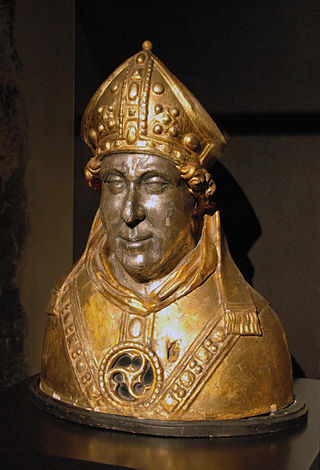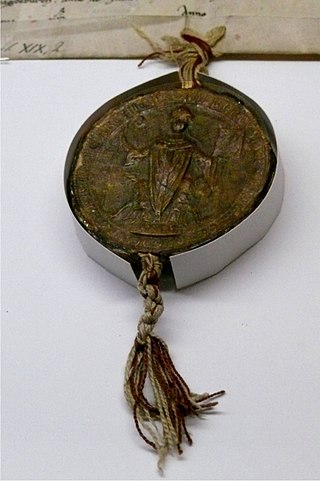Career
Dietrich's origins and family are not clear, although in the year 1166, he was appointed as pastor of the Saint Apostles church in Cologne. In 1199, he opposed Engelbert von Berg in the election to the Cologne cathedral chapter. Dietrich would not accept his defeat he continued arguing the election until 1204. After the deposition of Archbishop Bruno IV, Archbishop of Cologne, upon the urging of Otto IV, Holy Roman Emperor, he was unanimously elected as Archbishop on 22 December 1208, over the opposition, Bruno's nephew, Engelbert II of Berg. Dietrich received priestly and episcopal ordination on 24 May 1209. [1]
The German states had been in turmoil since the late 1190s; the family of the House of Welf competed with the House of Hohenstaufen, a Swabian family, for primacy within the Holy Roman Empire. After a decade of fighting and maneuvering, Otto had secured his own election, only to lose the throne in 1208 and regain it a year later. In 1209, he secured his formal election and coronation as Holy Roman Emperor through the extension of promises to potential supporters in the German lands, and by agreeing with Pope Innocent III to curtail the imperial influence on the Italian peninsula. In 1212, the fighting over the imperial crown broke out again, and Dietrich von Hengebach supported Otto; Innocent excommunicated Otto in 1212. Dietrich refused to accept this excommunication, and was himself placed under interdict. Despite his own excommunication, he continued to celebrate the Holy Mass and used the Holy Oils on Maundy Thursday. The papal legate and the Archbishop of Mainz interceded, and later in 1212 replaced Dietrich with his opponent in the election of 1208, Engelbert von Berg. [1]
Dietrich brought a legal suit to be reinstated; the suit dragged on for three years. At the Battle of Bouvines, on 27 July 1214, Dietrich's ally, Otto, was defeated. [2] A year later Dietrich's suit was rejected. He retired to the deanery at the Apostles church, and died there after 1223. The Cathedral Chapter of Cologne paid the expenses on his lawsuit until 1238. [1]

Otto IV was the Holy Roman Emperor from 1209 until his death in 1218.
Philip of Swabia was a member of the House of Hohenstaufen and King of Germany from 1198 until his assassination.

The Archbishop of Cologne is an archbishop governing the Archdiocese of Cologne of the Catholic Church in western North Rhine-Westphalia and is also a historical state in the Rhine holding the birthplace of Beethoven and northern Rhineland-Palatinate in Germany and was ex officio one of the Prince-electors of the Holy Roman Empire, the Elector of Cologne, from 1356 to 1801.

Henry (VII) (1211 – 12? February 1242), a member of the Hohenstaufen dynasty, was King of Sicily from 1212 until 1217 and King of Germany (formally Rex Romanorum) from 1220 until 1235, as son and co-ruler of Emperor Frederick II. He was the seventh Henry to rule Germany, but in order to avoid confusion with the Luxembourg emperor Henry VII, he is usually numbered Henry (VII).

Count Engelbert II of Berg, also known as Saint Engelbert, Engelbert of Cologne, Engelbert I, Archbishop of Cologne or Engelbert I of Berg, Archbishop of Cologne was archbishop of Cologne and a saint; he was notoriously murdered by a member of his own family.

Count Frederick of Isenberg was a German noble, the younger son of Arnold of Altena. Before the split between Arnold of Altena-Isenberg the eldest and his brother Friedrich Altena-Mark the younger son of Everhard von Berg-Altena. His family castle was the Isenberg near Hattingen, Germany.
Adolf of Altena, Adolf of Berg or Adolf of Cologne, was Archbishop of Cologne from 1193 to 1205.

Henry V, the Elder of Brunswick, a member of the House of Welf, was Count Palatine of the Rhine from 1195 until 1212.

Albert I of Käfernburg was Archbishop of Magdeburg from 1205 until his death.
Heinrich I von Müllenark (1190–1238) was the Archbishop of Cologne within the Holy Roman Empire from 1225 until 1237.

The House of Limburg-Stirum, which adopted its name in the 12th century from the immediate county of Limburg an der Lenne in what is now Germany, is one of the oldest families in Europe. It is the eldest and only surviving branch of the House of Berg, which was among the most powerful dynasties in the region of the lower Rhine during the Middle Ages. Some historians link them to an even older dynasty, the Ezzonen, going back to the 9th century.

Beatrice or Beatrix of Swabia, a member of the Hohenstaufen dynasty, was Holy Roman Empress and German Queen in 1212 as the first wife of the Welf emperor Otto IV. She was also the shortest-serving Holy Roman Empress, dying three weeks into her marriage.

Maria of Brabant, a member of the House of Reginar, was Holy Roman Empress from 1214 until 1215 as the second and last wife of the Welf emperor Otto IV.
Conrad of Scharfenberg was a German cleric who became bishop of Speyer and later, simultaneously, bishop of Metz (1212–24). He came from a family of knights who served the Holy Roman Empire from the area around Trifels Castle. His family castle was Scharfenburg.

Theoderich von Wied was Archbishop and Prince-elector of Trier from 1212 until his death.
The German throne dispute or German throne controversy was a political conflict in the Holy Roman Empire from 1198 to 1215. This dispute between the House of Hohenstaufen and House of Welf was over the successor to Emperor Henry VI who had just died. After a conflict lasting 17 years the Hohenstaufen Frederick II prevailed.
Conrad of Krosigk was a German prelate, crusader and monk. He served as the bishop of Halberstadt from 1201 until 1208 and took part in the Fourth Crusade in 1202–1204. He resigned his see to become a Cistercian monk at Sittichenbach Abbey. In his retirement, he undertook frequent Papal missions.
This page is based on this
Wikipedia article Text is available under the
CC BY-SA 4.0 license; additional terms may apply.
Images, videos and audio are available under their respective licenses.











